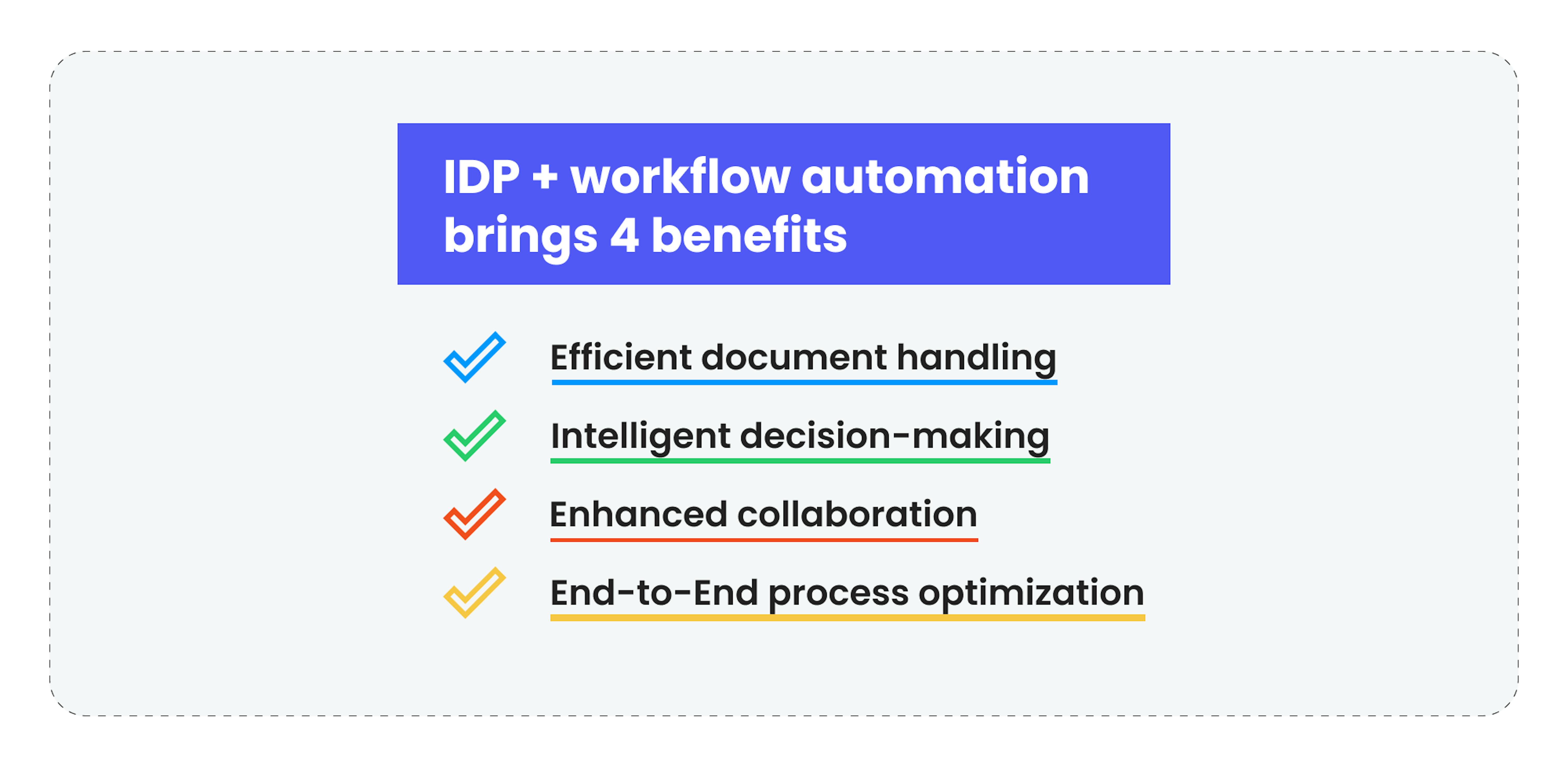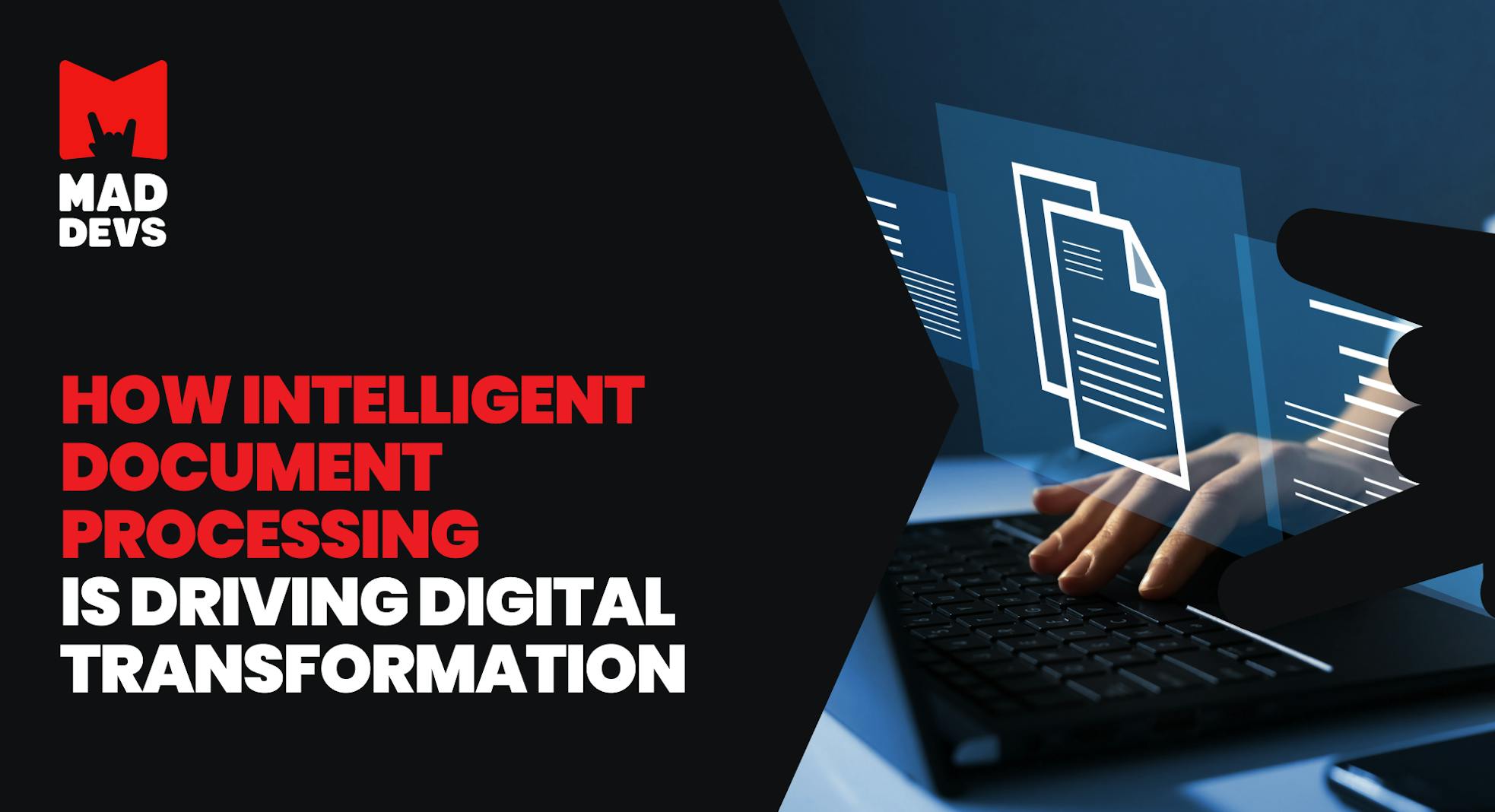Intelligent Document Processing (IDP) is indeed gaining significant traction in the business world as organizations recognize its potential to improve efficiency and reduce errors in document management.
Traditionally, businesses relied on manual data entry for document processing, which was time-consuming and prone to errors. This approach often resulted in data loss, frustration, and inefficiencies. However, with the development of automated and intelligent document-processing technologies, businesses now have access to more streamlined and reliable methods of handling document-related tasks.
In this article, we will delve into the advantages of intelligent document processing and examine how it empowers businesses to gain a competitive edge in their respective industries.
The evolution of IDP
First of all, it is important to talk about business documents and several problems that cost time and money:
- Wide variety of layouts (documents have tables, images, different sections, and more data variance that makes automation more challenging)
- Poor image resolution or scanning quality (documents have a wide range of noise that can come from scanning documents, taking pictures, or just low-quality PDFs)
- Archaic documents stored on paper
- Important handwritten details
- Some document types (legal, financial) require an expert understanding of the domain.
- Manual document processing is slow and often has repetitive tasks.
And the solution for some of these problems was Optical Character Recognition (OCR). It is a technology widely recognized for extracting and interpreting printed or handwritten text from digital images of physical documents. OCR serves as a valuable tool for data entry, enabling the conversion of printed paper documents like passport documents, invoices, bank statements, or mortgage documents into digital text. By digitizing text, it becomes searchable within a document, allowing for easy retrieval and storage for various administrative tasks, such as invoicing and sales processing. OCR technology has significantly simplified and streamlined document management processes, reducing manual effort and improving data extraction and retrieval efficiency.
OCR technology has been used by businesses globally for many years now. While OCR has helped countless businesses around the world convert paper documents into scanned images, there are two significant limitations to the technology:
- OCR is based on a template and formatted to specific rules. This means it struggles to read and decipher unstructured data, like handwriting.
- OCR cannot extract any context from the content. This means it can't interpret data or automatically classify it, doesn't allow automated end-to-end processes.
IDP emerged in the early 2000s to address these limitations. IDP uses OCR to convert an image of text into readable text, harnessing AI, ML, and deep learning to capture, classify and extract all relevant data. This data can then be automatically fed into workflows for further processing. And in our days, IDP is gaining more and more popularity.
IPD market overview
The global IDP market size was valued at USD 1.2 billion in 2021 and is expected to expand at a CAGR of 29.7% from 2022 to 2030.
Use cases include:
- Invoice processing
- Digital document archiving
- Insurance claims processing
- Fraud detection
- Case reviews
- Contract administration
- Mortgage loan application processing
- Customer onboarding
Prominent players in the IDP processing market are:
- HYPERSCIENCE
- UiPath
- IBM
- ABBYY
- Automation Anywhere, Inc.
- Kofax Inc.
- WorkFusion, Inc.
- Datamatics Global Services Limited
- HCL Technologies Limited
- Appian
- AntWorks
Industries using IDP:
The target audience for IDP technology includes various industries, such as healthcare, retail, financial services, and government, since it can effectively contribute to digital transformation and operational optimization. Other industries such as legal, logistics, insurance, and education can also leverage IDP to enhance document processing, improve productivity, and achieve their specific objectives. The behaviors and preferences of these groups vary. For instance, some prefer to focus on efficiency and cost savings, while others prioritize compliance and security.
How does IDP work
IDP combines advanced technologies such as OCR, NLP, ML, and AI to automate the extraction, interpretation, and analysis of data from documents.

Let's delve into how IDP works and why it is revolutionizing document processing.
- Document ingestion and data capture:
The first step in IDP involves capturing documents in digital form. This can be done by scanning physical documents or ingesting electronic files such as PDFs or images. Once the documents are digitized, OCR technology converts the text into a machine-readable format, enabling further processing. - Data extraction and interpretation:
After capturing the documents, IDP utilizes OCR and NLP techniques to extract relevant information from the text. OCR technology recognizes and extracts text characters, while NLP algorithms analyze the language and context to understand the meaning of the extracted data. This allows IDP systems to identify key entities, such as names, dates, addresses, and other relevant data points. - Document classification and routing:
IDP employs ML and AI algorithms to classify documents into predefined categories based on their content, format, or other criteria. This categorization enables the efficient routing of documents to the appropriate departments or workflows for further processing. For example, invoices can be automatically routed to the finance department, while contracts can be directed to the legal team. - Output generation and integration:
Once the relevant data is extracted and the documents are classified, IDP generates structured output, such as databases, spreadsheets, or application integrations. This structured data can be seamlessly integrated with downstream systems or used for further analysis and decision-making.
The power of IDP lies in its ability to learn and improve over time. ML algorithms continuously analyze patterns in the data, allowing the system to adapt and enhance its accuracy in data extraction and interpretation. With each iteration, IDP becomes more efficient in processing different document types and handling variations in language and format.
SWOT analysis of IDP
Performing a SWOT (Strengths, Weaknesses, Opportunities, Threats) analysis enables organizations to gain valuable insights into the strategic positioning of a particular technology or solution. Let's apply this analysis to IDP to effectively assess its internal and external factors.
Strengths
- Automation and efficiency. IDP eliminates the need for manual data entry and streamlines document processing, leading to increased efficiency and productivity.
- Accuracy and data quality. By leveraging advanced technologies like OCR, NLP, ML, and AI, IDP improves data accuracy and reduces errors in document processing.
- Scalability and adaptability. It can handle large volumes of documents and adapt to different document types and formats, making them highly scalable and versatile.
- Time and cost savings. Significantly reduces processing time and resource requirements, resulting in business cost savings.
- Improved compliance. Ensures consistent and accurate handling of documents, aiding organizations in meeting regulatory requirements and maintaining compliance.
Weaknesses
- Dependence on document quality. IDP's effectiveness is influenced by the quality and legibility of the documents. Poor-quality scans or illegible text may hinder accurate data extraction.
- Initial setup and training. Implementing IDP requires initial setup, integration, and training, which may require additional resources and expertise.
- Complexity for unstructured documents. It may struggle with unstructured documents that lack a defined format or template, requiring additional efforts for accurate data extraction.
Opportunities
- Integration with emerging technologies. Can be integrated with other emerging technologies, such as Robotic Process Automation (RPA) or Intelligent Process Automation (IPA), to create more advanced and comprehensive automation solutions.
- Expansion to new industries. IDP can be applied to various industries beyond its current applications, such as legal, insurance, logistics, and more, presenting opportunities for market expansion.
- Continuous technological advancements. Advances in AI, ML, and NLP algorithms can further enhance the capabilities of IDP, improving accuracy and expanding its range of applications.
Threats
- Security and privacy concerns. IDP deals with sensitive data, and organizations must ensure robust security measures and compliance with data privacy regulations.
- Competition and market saturation. With gaining popularity, competition among solution providers may increase, leading to market saturation and pricing pressures.
- Resistance to change. Organizations may face resistance from employees accustomed to traditional document processing methods, requiring effective change management strategies.
When we talk about businesses streamlining their operations, increasing efficiency, and reducing manual effort, it's impossible not to mention another technology.
IDP and workflow automation are two technologies that have emerged as powerful solutions in this pursuit. While each technology has its own benefits, they also share a strong relationship, working together to optimize business processes and drive digital transformation. Let's explore the symbiotic relationship between IDP and workflow automation and how they contribute to enhanced operational efficiency.
The relationship between IDP and workflow automation
Workflow automation involves the design, implementation, and execution of automated workflows that streamline the flow of data and tasks between systems and individuals. It uses predefined business rules to automate the routing and processing of information, ensuring that tasks are executed efficiently and in a predefined sequence. Workflow automation eliminates manual handoffs, reduces errors, and enables consistent and timely execution of business processes.
One of the successful examples of it is our cooperation with Ready4Trade Central Asia (R4TCA). Their project used a paper-based manual mission report to track their activities with SMEs. R4TCA implementers saw digitalization as a major opportunity for improvement. Mad Devs developed a web application that improved reporting and coordination by giving the coaches a convenient tool to collect, process, and report data.
Here is our case study for more details:
The benefits of integrating IDP with workflow automation are numerous. Organizations can achieve faster document processing, improved accuracy, reduced operational costs, enhanced compliance, and increased productivity. Moreover, this integration enables organizations to achieve a holistic view of their processes, identify bottlenecks, and make data-driven decisions for continuous improvement.
The relationship between IDP and workflow automation is highly complementary. Let's examine how they work together to streamline business operations:

Efficient document handling
IDP automates document processing by extracting data and transforming it into structured formats. This structured data can then seamlessly flow into automated workflows, triggering the necessary actions and routing the documents to the relevant stakeholders. Workflow automation ensures that documents are handled efficiently, guiding them through predefined steps and approvals, reducing bottlenecks, and improving overall document management.
Intelligent decision-making
IDP's advanced capabilities, such as ML and AI, enable it to analyze document content, extract insights, and make intelligent decisions. Workflow automation leverages these insights to automate decision-making within workflows. For example, based on IDP's analysis of an invoice, workflow automation can automatically approve or flag it for further review, eliminating the need for manual intervention and expediting the approval process.
Enhanced collaboration
IDP and workflow automation foster collaboration by providing a centralized platform for document sharing, annotation, and task assignment. IDP ensures that the right information is available to the right people at the right time, while workflow automation assigns tasks and notifications to relevant stakeholders, ensuring smooth collaboration and timely completion of activities.
End-to-end process optimization
When IDP and workflow automation are combined, organizations can achieve end-to-end process optimization. IDP automates the front-end document processing, while workflow automation handles the subsequent steps, including task assignments, notifications, and approvals. This seamless integration minimizes manual handoffs, reduces processing time, and eliminates errors, resulting in significant operational efficiency gains.
Let's explore some examples of how companies leverage IDP technologies to transform their business.
Examples of where to use IDP
By automating document-centric tasks, businesses can allocate resources more effectively and focus on higher-value activities. IDP offers immense potential for organizations across various industries, bringing tangible benefits regarding time savings, cost reduction, and improved data accuracy. Here are specific use cases:
Legal service agreement
The process of reviewing legal service agreements involves reviewing key information such as the terms of service, the payment amount, and the party information. Usually, a high-level review takes around an hour, while a detailed review can take much longer.
With the help of intelligent document processing, businesses can significantly reduce the time and costs involved in their legal service agreements. It can summarize a 30-page document in just a few sentences while retaining the important legal terms.
Invoice and receipt processing
Businesses of all sizes need to automate their receipt and invoice processing to improve their efficiency. Unfortunately, both manual and template-based approaches can be very time-consuming and costly. They also tend to have issues with the variety of layouts and background noise.
Automated invoice processing solutions that utilize a deep learning framework typically only take around three seconds to process each invoice. This significantly lowers the cost of processing and provides a high level of coverage for variance.

Resume processing and extracting information
Similar to how we process documents, a deep learning framework can be used to extract key information from a resume. This process can be performed by going from a standard format to a structured JSON field with more accuracy.
To train this document processing framework, companies gather resume formats from various common sources like LinkedIn and Google Docs. Additionally, they can incorporate custom multi-column examples with greater variance and more fields to ensure robustness and versatility. Unlike traditional rules-based or template-based systems, modern intelligent document processing pipelines allow for easy scalability to accommodate new resume sources as they emerge.
📖 If you want to know more about how to use AI for recruitment and Mad Dev's experience to automate hiring processes and store organizational data, check this article.
Document processing in law
Important information, such as the names of litigants, judges, defendants, and attorneys, is typically kept on the cover sheets of legal papers. Transferring and reviewing these documents manually can take several hours.
Using IDP can help law firms and courts reduce their time on manual document processing. It can extract data from over 60 different types of cover sheets and can also convert complex documents.
💡 Are you interested in automating document-centric tasks for extracting valuable information? Our specialists can help you, book a free consultation to discuss issues and future steps for building or implementing software for IDP.
Future trajectory of IDP
The future of IDP is an exciting area of technology with endless possibilities. In the next few years, we can expect to see tremendous advancements in the way we interact with, analyze, and process large volumes of information contained in documents. Here are five trends guiding the future of IDP innovation.
Documents integrate deeper into workflows. IDP is no longer just about sorting and storing documents; it's about integrating them seamlessly into workflows.
Training models are the new gold standard. As businesses scale and the volume of incoming documents increases, there is a growing need for IDP tools that can process large volumes of documents efficiently and accurately.
Machine learning models tackle new forms of media. While documents have traditionally been paper-based, today's society generates vast amounts of unstructured data in various forms, such as videos, images, webinars, and social media content. Machine learning models, supported by NLP, are evolving to handle these new forms of media. The future of IDP will involve more sophisticated tools that can understand the meaning of text and process non-traditional media, opening up new applications like automatic summarization, translation, and question-answering.
Improved accuracy. LLMs are expanding computers' situational awareness and context comprehension. These models understand the context of documents, enabling improved accuracy in IDP systems.
Enhanced user experience. The future of IDP will focus on improving the user experience, making it more intuitive, efficient, and user-friendly
Conclusion
IDP is a transformative technology that revolutionizes document processing by leveraging OCR, NLP, ML, and AI. By automating data extraction, interpretation, and analysis, IDP streamlines business operations, reduces errors and enables organizations to make better-informed decisions. As businesses continue to generate and handle vast amounts of data, embracing IDP becomes essential for staying competitive in the digital era.
The future of this technology is exciting and full of potential. With advancements in machine learning, NLP, and user experience, IDP will enable organizations to streamline processes, reduce costs, and gain valuable insights from the vast amounts of information contained in documents. These trends will drive innovation in IDP, making it easier and more efficient than ever to process and analyze documents, regardless of their format or structure.
Are you interested in automation? Gladly, Mad Devs' mission is to automate everything. Contact us and we will help you streamline and adjust processes at every stage.











